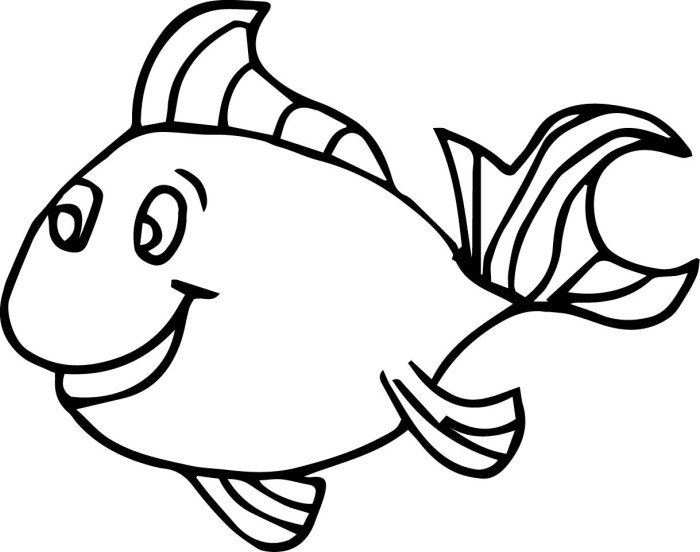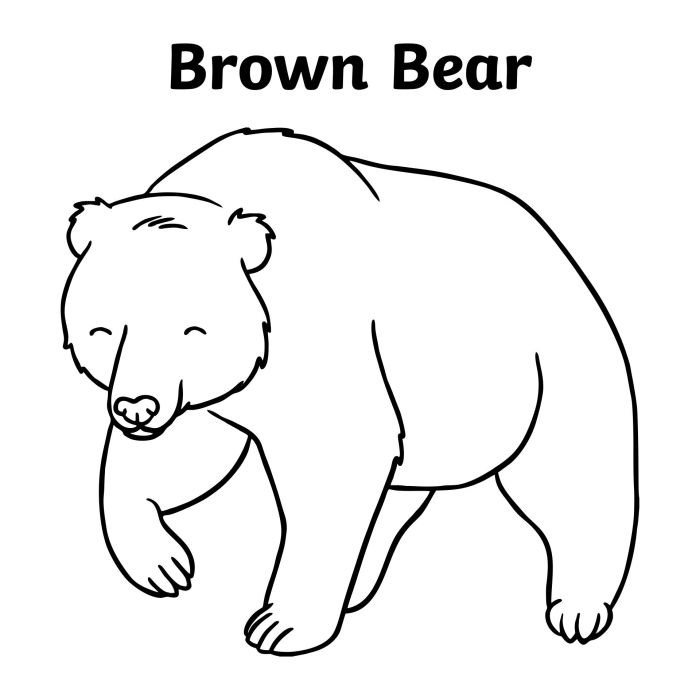Market Research
Fish coloring book page – The market for children’s coloring books is vast and diverse, with numerous niches catering to specific interests. Fish-themed coloring books represent a segment within this larger market, appealing to children with an affinity for marine life and aquatic creatures. Understanding the current demand, competition, and target audience is crucial for successful product development and marketing.
Current Market Demand for Fish-Themed Coloring Books
The demand for fish-themed coloring books is driven by several factors, including the inherent appeal of colorful fish to children, the educational potential of learning about different species, and the general popularity of coloring activities as a relaxing and creative pastime. While precise sales figures for this specific niche are difficult to obtain publicly, the broader children’s coloring book market shows consistent demand, indicating a viable market for specialized themes like fish.
The success of similar themed coloring books (e.g., those featuring animals, dinosaurs, or mythical creatures) suggests a strong potential for a well-executed fish-themed offering. Parents and educators also recognize the value of coloring books as educational tools, further bolstering demand.
Top Three Competitors and Product Analysis
Identifying direct competitors is challenging without access to proprietary market data. However, we can analyze successful coloring book publishers with similar themes. For example, a hypothetical competitor, “Ocean Wonders Coloring Books,” might offer a comprehensive collection featuring diverse fish species with realistic illustrations and simple backgrounds. Another, “Rainbow Reef,” could focus on stylized, cartoonish fish, aimed at a younger age group.
Finally, “Deep Sea Discoveries” might present a more educational approach, incorporating facts about each fish species alongside the coloring pages. A comparative analysis would involve evaluating the artwork style, educational content (if any), pricing, and overall market positioning of these competitors.
Target Age Range for Fish-Themed Coloring Pages, Fish coloring book page
The primary target age range for fish-themed coloring pages likely spans from preschool (ages 3-5) to early elementary school (ages 6-8). Younger children might be drawn to simpler designs with bold colors and large Artikels, while older children might appreciate more detailed illustrations and potentially challenging patterns. However, the appeal of fish can extend beyond this age range, with older children and even adults finding enjoyment in coloring intricate designs.
This broader appeal opens up additional marketing opportunities.
A fish coloring book page offers a delightful way for children to explore their creativity. The intricate details of scales and fins provide ample opportunity for artistic expression, and it’s a fun way to learn about different species. For a broader range of coloring options, consider supplementing the fish page with images from resources like this collection of 3 books clipart coloring , which offers diverse subjects beyond marine life.
Returning to our fishy friend, remember to use vibrant colors to bring your underwater scene to life!
Marketing Strategies to Reach Target Audiences
Effective marketing strategies would involve targeting parents, educators, and children directly. Online marketing through social media platforms, particularly those frequented by parents and educators (such as Facebook and Instagram), would be crucial. Collaborations with educational institutions or children’s museums could offer promotional opportunities. Targeted advertising on websites and apps frequented by children and families could also be effective.
Additionally, partnerships with relevant retailers, such as bookstores and toy stores, would help increase visibility and accessibility of the coloring book. Print advertising in parenting magazines or educational publications could also be considered.
Educational Aspects: Fish Coloring Book Page

This section details the incorporation of educational elements into the fish coloring book, focusing on enhancing learning through engaging designs and subtle integration of conservation messages. The aim is to create a fun and informative experience for young learners.
Coloring Page Designs with Educational Elements
Three coloring pages will be designed, each focusing on a different aspect of fish life. The first page features a clownfish in its anemone habitat. The illustration will depict the symbiotic relationship between the clownfish and the anemone, clearly showing how the anemone provides protection for the clownfish, while the clownfish helps clean the anemone. A brief description of symbiosis will be included near the coloring area.
The second page showcases a variety of fish found in a coral reef ecosystem, highlighting the diverse range of colors, shapes, and sizes. A simple key will identify each fish and briefly describe its unique characteristics. The third page focuses on a group of different types of fish and the foods they eat, depicting a predator-prey relationship. For instance, it could show a shark with smaller fish, illustrating the food chain.
Labels will identify each fish and its primary food source.
Subtle Integration of Ocean Conservation Facts
Ocean conservation messages will be subtly woven into the designs through visual cues and short text snippets. For instance, the coral reef page might depict a section of bleached coral, prompting a discussion about the impact of climate change on marine ecosystems. A small, informative text box could explain how pollution affects ocean life. The page about the food chain could subtly show the impact of overfishing on the balance of the ecosystem.
The text would encourage children to consider the impact of their actions on marine life.
Fun Facts about Fish
The following fun facts about fish are suitable for inclusion within the coloring book pages:
These facts will be interspersed throughout the coloring pages, adding an element of surprise and further enriching the learning experience.
- Some fish can change color to blend in with their surroundings!
- Electric eels can generate powerful electric shocks to stun prey.
- The largest fish in the ocean is the whale shark, which can grow up to 40 feet long!
- Many fish use bioluminescence (producing their own light) to attract mates or prey.
- Fish have gills that allow them to breathe underwater.
Highlighted Fun Fact Example
The whale shark, the largest fish in the ocean, is a gentle giant that feeds on plankton. It’s a filter feeder, meaning it strains tiny organisms from the water.
Content Production and Organization

This section details the plan for producing and organizing the coloring book’s content, ensuring a logical flow and engaging experience for the user. The focus is on creating a cohesive and progressively challenging sequence of coloring pages, complemented by supplementary educational elements and potential additional features.The organization of the coloring pages aims to balance increasing complexity with thematic coherence, creating a natural learning progression.
This approach ensures that younger children are not discouraged by overly challenging pages, while older children are sufficiently stimulated.
Page Sequencing and Rationale
The coloring pages will be organized into three sections: “Ocean Explorers,” “Coral Kingdom,” and “Deep Sea Divers.” “Ocean Explorers” will feature simpler designs of common fish like goldfish and clownfish, focusing on basic shapes and large areas for coloring. This section is designed for younger children. “Coral Kingdom” introduces more intricate designs, incorporating more detail and smaller areas, suitable for children with intermediate coloring skills.
This section introduces a wider variety of fish species found in coral reefs. Finally, “Deep Sea Divers” features the most complex designs, with detailed textures and smaller, more challenging areas to color, targeting older children with advanced coloring abilities. This section introduces less common deep-sea fish and more complex underwater environments. This progression in complexity provides a gradual challenge, maintaining engagement throughout the book.
Sample Page Layout
A typical page will feature a large coloring area on the left-hand side, occupying approximately two-thirds of the page. The right-hand side will contain a smaller section with educational content related to the fish depicted on the left. This could include a brief description of the fish, its habitat, and interesting facts. For example, a page featuring a clownfish might include information about its symbiotic relationship with sea anemones.
At the bottom of the page, a small area might be dedicated to a simple activity, such as a short maze or a word search related to the page’s theme. This ensures a balanced combination of coloring and educational engagement. The overall layout is designed to be visually appealing and easy to navigate. The color scheme will be consistent with the underwater theme, utilizing calming blues, greens, and other ocean-inspired hues.
Potential Additional Features
Several additional features could enhance the coloring book experience. A set of high-quality stickers featuring the fish from the coloring pages would provide an extra layer of creative expression. These stickers could be used to decorate the finished pages or create separate artwork. Furthermore, including a small section of simple, age-appropriate puzzles or mazes related to ocean life would provide additional entertainment and educational value.
Finally, the inclusion of a perforated section at the back, allowing for the removal of finished pages for display or sharing, would increase the book’s overall appeal. These additions would transform the coloring book from a simple activity into a more interactive and engaging learning tool.



